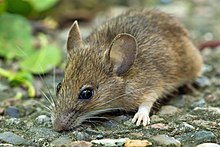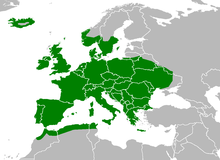| Wood mouse | |
|---|---|

| |
| Scientific classification | |
| Domain: | Eukaryota |
| Kingdom: | Animalia |
| Phylum: | Chordata |
| Class: | Mammalia |
| Order: | Rodentia |
| Family: | Muridae |
| Genus: | Apodemus |
| Species: | A. sylvaticus
|
| Binomial name | |
| Apodemus sylvaticus | |

| |
| Apodemus sylvaticus range (in green) | |
| Synonyms | |
|
Mus sylvaticus Linnaeus, 1758 | |
The wood mouse (Apodemus sylvaticus) is a murid rodent native to Europe and northwestern Africa. It is closely related to the yellow-necked mouse (Apodemus flavicollis) but differs in that it has no band of yellow fur around the neck, has slightly smaller ears, and is usually slightly smaller overall: around 90 mm (3.54 in) in length and 23 g in weight.[2] It is found across most of Europe and is a very common and widespread species, is commensal with people and is sometimes considered a pest.[1] Other common names are long-tailed field mouse, field mouse, common field mouse, and European wood mouse.[3] This species is a known potential carrier of the Dobrava sequence of hantavirus which affects humans and may pose serious risks to human health.[4]

- ^ a b Schlitter, D.; van der Straeten, E.; Amori, G.; Hutterer, R.; Kryštufek, B.; Yigit, N.; Mitsainas, G. (2021) [amended version of 2016 assessment]. "Apodemus sylvaticus". IUCN Red List of Threatened Species. 2021: e.T1904A197270811. doi:10.2305/IUCN.UK.2021-1.RLTS.T1904A197270811.en. Retrieved 23 April 2021.
- ^ Alcántara, M. (1991). "Geographical variation in body size of the Wood Mouse Apodemus sylvaticus L.". Mammal Review. 21 (3): 143–150. doi:10.1111/j.1365-2907.1991.tb00115.x.
- ^ Wrobel, Murray. (2006). Elsevier's Dictionary of Mammals. Elsevier, ISBN 978-0-444-51877-4.
- ^ Weidmann, Manfred; Schmidt, P.; Vackova, M.; Krivanec, K.; Munclinger, P.; Hufert, F. T. (February 2005). "Identification of Genetic Evidence for Dobrava Virus Spillover in Rodents by Nested Reverse Transcription (RT)-PCR and TaqMan RT-PCR". Journal of Clinical Microbiology. 43 (2): 808–812. doi:10.1128/JCM.43.2.808-812.2005. ISSN 0095-1137. PMC 548048. PMID 15695684.
